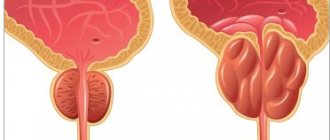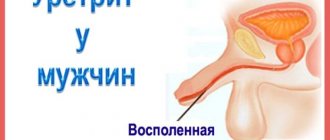When a man has problems with urination, this is a reason to seriously think about his male health. Unfortunately, such problems occur quite often in men, and most of them indicate the presence of serious diseases, usually urological.
Usually, when a man complains about problems with urination, he means that it has become too frequent or too rare, painful, accompanied by a burning sensation, or sluggish and difficult, a feeling of incomplete emptying of the bladder .
Most often, men have problems with urination because inflammation of the prostate gland, prostate adenoma, and prostate cancer develops. As the prostate enlarges, it puts pressure on the urethra, blocking it. This is what makes urination difficult, and in severe cases almost impossible. In addition, the cause of painful and difficult urination is an infection in the genitourinary area.
When difficulty urinating is observed in the morning against the background of erectile dysfunction, and this is accompanied by general malaise, these are the first symptoms of prostatitis. In this case, it is this that causes difficulty urinating.
In any case, whatever the causes of problems with urination, this is a serious reason to see a urologist!
Causes
There are a number of reasons that cause problems with urination in men:
- weak bladder;
- weak pelvic muscles;
- urethritis;
- use of certain medications;
- neurological problems (such as spinal cord or brain disorders);
- enlargement of the prostate gland (prostatitis, adenoma);
- urinary tract infections;
- age-related changes after 50 years.
Treatment of weak urination in men
The method of treatment depends on the diagnostic results. Let's talk about common pathologies.
Infectious lesions
If infections are found in biological fluids, a course of antibiotics is prescribed. The choice of active substance depends on the type of pathogen detected. Medicines used to treat urinary tract infections in men are listed in the table below.
Prices for drugs:
- “Ciprofloxacin” - 37 rubles for 10 tablets of 500 mg.
- “Levofloxacin” - 440 rubles for 10 tablets of 50 mg.
- “Furadonin” (nitrofurantoin) – 97 rubles for 20 tablets of 50 mg.
- “Monural” (fosfomycin) – from 360 rubles for 2 g.
- "Amoxicillin" - 95 rubles for 16 tablets of 500 mg.
- "Cefalexin" - 89 rubles for 16 capsules of 500 mg.
- “Amoxiclav” (amoxicillin + clavuanic acid) – 372 rubles for 14 capsules.
- “Cefixime” - 500 rubles for 7 tablets of 400 mg.
Uroseptics and non-steroidal anti-inflammatory drugs are prescribed as auxiliary therapy.
Herbal uroseptics and their cost:
- "Urolesan" - 339 rubles.
- "Canephron" - 585 rubles.
- “Phytolysin” (paste) - 387 rubles.
The paste for preparing the “Fitolysin” suspension has a diuretic, anti-inflammatory and antispasmodic effect. Price from 445 rubles
Non-steroidal anti-inflammatory drugs include Ibuprofen, Nurofen, Ketorol. They are prescribed to relieve pain and reduce swelling.
Adenoma
Difficulty urinating due to adenoma can be alleviated with the following medications:
- 5-alpha reductase inhibitors: finasteride, dutasteride. Prescribed when the prostate grows to a volume of more than 40 cm3. Course from 6 months to a year. Drugs: Avodart (1989 rubles for 30 capsules), Finasteride (312 rubles for 30 tablets).
- PDE5 inhibitors: tadalafil. The drug improves the quality of blood flow and reduces the severity of inflammatory processes. They are usually used in combination with alpha-blockers (a well-known drug based on tadalafil is tadalafil-sz).
- Alpha blockers: alfuzosin, terazosin, doxazosin, tamsulosin. Tamsulosin-based drugs cause the least side effects and are easy to take. The most popular are “Omnik” (costs 321 rubles) and “Duodart”, which includes tamsulosin and the selective 5-alpha reductase inhibitor dutasteride (1,759 rubles for 30 capsules).
Therapy with the above drugs is lifelong. For severe difficulty urinating, surgical treatment is used:
- Transurethral resection using a resectoscope with an electric loop or laser. Usually performed when the gland volume is 30-80 cm3.
- Surgical removal - adenomectomy.
Types of operations to remove prostate adenoma, their pros and cons.
Timely consultation with a doctor and supportive conservative therapy help to avoid surgical intervention.
Strictures, cysts and tumors
Strictures and neoplasms of the urethral canal are excised using a resectoscope under video control. In some cases, strictures are of great extent, in which case it is necessary to excise the affected area and sew together the ends of the urethra or resort to plastic surgery.
Video of excision of paraurethral urethral cyst
At home
A weakening stream of urine is a signal to consult a doctor. Trying to do anything at home is dangerous. Traditional methods can be used only after diagnosis with the permission of a doctor.
Fruit drinks made from lingonberries and cranberries, decoctions of chamomile, sage, lingonberry leaf, horsetail, goldenrod, and bearberry help to cope with urinary tract infections.
For prostatitis and adenoma, suppositories with propolis, parsley juice, tincture of birch buds, pumpkin seeds with honey are used.
Diagnostics
A urologist performs a full comprehensive examination. The program of such examination includes:
- examination of the patient, palpation of the external genitalia and prostate gland;
- hardware diagnostics;
- Ultrasound of the prostate gland;
- Ultrasound of the bladder;
- sexual function test with intracavernous injection of a vascular drug (according to indications);
- laboratory diagnostics (according to indications).
If the doctor deems it necessary, the following may also be performed:
- additional laboratory tests (blood tests, urine tests, spermogram, tests for sexually transmitted infections);
- computed tomography (CT);
- puncture biopsy of the prostate;
- X-ray examinations;
- scintigraphy;
- urethroscopy;
- Doppler examination of blood vessels (Dopplerography);
- biothesiometry - determination of the sensitivity of the skin and mucous membranes;
- cystoscopy.
How does prostate adenoma develop?
Prostate adenoma is characterized by gradual development, which can be divided into three stages.
- The first stage of the disease occurs with minimal urination disturbances. There may be a slight increase in frequency, especially at night, and a sluggish stream of urine. The first stage can last from one year to 12 years or more.
- The second stage of prostate adenoma is characterized by more pronounced urination disorders: intermittent urine stream, the need to strain when urinating and a feeling of incomplete emptying of the bladder. Residual urine, which is retained in the bladder and urinary tract, causes an inflammatory process, which is accompanied by pain, a burning sensation when urinating, pain in the lumbar region and above the pubis.
- The third stage is characterized by periodic or constant involuntary leakage of urine, which forces the patient to use a urinal.
Treatment
Treatment is selected individually after the urologist conducts a full examination and identifies the cause of the disease.
Urologists at Alan Clinic provide complex treatment, which may include the following techniques:
- drug treatment;
- physical therapy;
- prostate massage;
- treatment with active oxygen (ozone therapy);
- mud therapy (Dead Sea mud);
- medical and medicinal droppers;
- adjusting the patient’s lifestyle and nutrition;
- development of an individual prevention program;
- monitoring the patient's condition after treatment.
Reviews about the treatment
Here are reviews of drugs for the treatment of the most common cause of difficulty urinating - adenoma.
From the forum https://otabletkah.ru/lekarstva-i-bady/duodart/otzyvy:
Reviews from doctors and patients about Avodart from the forum https://protabletky.ru/avodart/:
Reviews about "Urolesan":
Vitamin E 400
Tocopherol acetate or vitamin E is often included in the complex treatment of prostate adenoma as an antioxidant, radioprotective agent and an indispensable link in reproductive processes.
Vitamin E in a dosage of 400 mg is prescribed by urologists to patients with disorders of erectile function and spermatogenesis associated with prostate adenoma. Treatment of such a serious chronic disease as prostate adenoma should be prescribed and monitored by a urologist. Taking certain medications on your own, without prior consultation with your doctor, is strictly prohibited, since self-medication in this case may not only be ineffective, but also dangerous for men’s health. Only a qualified specialist can tell you which tablets for prostate adenoma are the most effective in each specific case, and which of them can cause negative consequences.
Drugs for the treatment of prostatitis and prostate adenoma
There is a certain scheme according to which specific drugs are prescribed for the treatment of prostatitis and prostate adenoma.
High effectiveness of treatment is achieved through the use of drugs from the group of alpha-reductase inhibitors and alpha-blockers. These drugs for the treatment of prostate adenoma in men help eliminate the main symptoms of the disease, as well as restore sufficient urination. What are the most effective and widely used tablets for prostate adenoma? The list is topped by alpha1-adrenergic receptor blockers. In addition, this list includes 5-alpha reductase inhibitors, vitamins and minerals.
The complex of drug therapy includes not only drugs. For prostate adenoma, conservative treatment can be supplemented with biologically active additives - dietary supplements, which enhance the therapeutic effect of drugs and ensure a speedy recovery. Some of them contain zinc. This macroelement is directly involved in spermatogenesis and testosterone synthesis. Plant phytosterols normalize urination.
Treatment with drugs from the group of alpha1-adrenoceptor antagonists
These drugs for the treatment of prostatitis and prostate adenoma provide relaxation of the smooth muscles of the urinary system and improve the process of urine discharge.
Tamsulosin, with the same name as the active substance, which is included in other drugs (Alfuzosin, Omnic, Silodosin, Urorek, etc.), is a highly selective drug that has a selective effect on alpha1-adrenergic receptors of the muscles of the prostate gland, prostatic urethra and bladder. Due to the decrease in muscle tone, the outflow and excretion of urine is facilitated. Tamsulosin, like all selective drugs, has minimal side effects, does not affect vascular tone and can be prescribed to patients with chronic hypertension. Alpha-adrenergic antagonists must be used continuously, thereby achieving a gradual reduction in irritation and obstruction in prostate adenoma. The drug Omnic in the treatment of prostate adenoma occupies a well-deserved priority in the prescriptions of urologists. It is produced by the Japanese company Astellas Pharma in the form of capsules and tablets (Omnic Okas). How long can you take Omnic without interruption? This directly depends on the stage of the disease. It is strongly recommended that for the risk of exceeding the dosage, consult your doctor about taking the drug and its dosage limits.
The tablet form of the drug is considered more progressive, since thanks to the controlled release of tamsulosin, the active substance is in the body in a constant concentration. The medicine enters the bloodstream evenly, thereby reducing the likelihood of developing the main side effect of drugs from the adrenergic blocking group - a sharp decrease in blood pressure.
An equally effective drug with the active ingredient tamsulosin is Urorek. Taking this drug is not accompanied by the following undesirable effects: orthostatic hypotension, tachycardia, increased frequency of angina attacks in patients with coronary heart disease, so it can be prescribed to men with cardiac pathologies. Properly selected dosage and compliance with all rules for the use of drugs from the alpha-blocker group make it possible to achieve a good therapeutic effect with an almost complete absence of side effects.
Medicines from the group of reductase inhibitors (blockers)
Drugs of this pharmacological group (Finasteride, Penester, Alfinal, Dutasteride, Avodart) help facilitate the outflow of urine, and, therefore, eliminate the main symptoms of the disease.
A stable therapeutic effect occurs within two to three weeks after the start of the course. All symptoms disappear completely after three months. According to the results of clinical studies, maximum effectiveness is achieved after six months of therapy with these drugs. Finasteride and Dutasteride are specific inhibitors of type 2 5-alpha reductase (the cellular enzyme responsible for the transformation of testosterone into dihydrotestosterone). The growth of the prostate gland in prostate adenoma is directly related to a similar transformation of testosterone. Thanks to 5-alpha reductase inhibitors, the production of intraprostatic dihydrotestosterone is blocked and its concentration in the blood is significantly reduced.
Finasteride and Dutasteride are used for the following purposes:
- Treatment and control of prostatic hyperplasia;
- Improving the outflow of urine and eliminating the symptoms of prostate adenoma;
- Reducing the risk of developing acute urinary retention and the need for surgical intervention.
Finasteride and Dutasteride have a pronounced antiandrogenic effect, i.e. help reduce the level of male hormones in the blood. In addition, these drugs have a teratogenic effect, so they should be taken with caution. With the help of modern medications, it is possible to stop the growth of the prostate and prevent the need for surgical treatment.
Prevention of the prostate gland in men
There are certain rules for the prevention of prostate adenoma, following which you can maintain the health of this important organ:
- Follow a diet - reduce consumption of red meat and fatty foods. A man's diet should be dominated by vegetables, fruits, and omega acids;
- Increase physical activity – physical exercise has a positive effect on prostate health;
- Control your body weight – this will significantly reduce the risk of developing prostate adenoma;
- Minimize stress – will improve hormonal levels and slow down the development of the disease;
- Have an active sex life;
- After 45-50 years, be systematically examined by a urologist and take an analysis of the dog’s blood level.
Prostate adenoma, detected in the early stages of development, can be corrected with medication and non-surgically without any problems.
Timely contacting a urologist and unquestioningly following all his instructions for treating the disease in almost all cases guarantees stopping the growth of the gland and preventing urinary disorders. Late stages of the disease with symptoms that significantly reduce a man’s quality of life will require the use of surgical treatment methods. Therefore, early diagnosis of prostate adenoma is of great importance, which can be done in the modern medical center of Moscow - the Yusupov Hospital. The clinic’s high-tech diagnostic equipment ensures the most accurate research results, thanks to which Yusupov Hospital specialists select an effective individual treatment regimen for each patient, whenever possible, giving preference to non-surgical, gentle treatment methods.
Make an appointment










